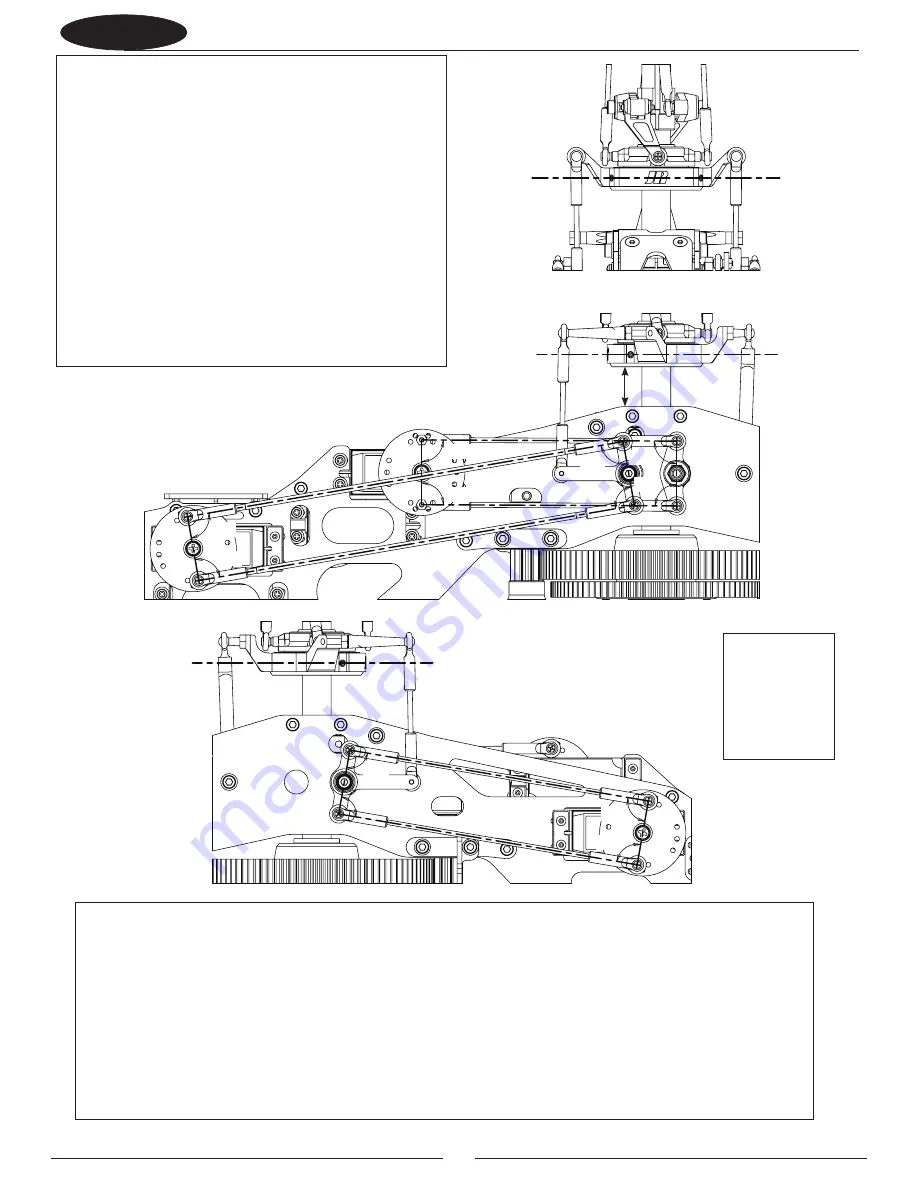
65
After the control linkages have been attached to the
swashplate, it will be necessary to check the swashplate to
ensure that it is level. To do this, turn on the radio system and
place the collective stick in the center position as before. Next,
check to make sure that all trim levers and knobs are also in
their center position. Check to ensure that the servo arms are
parallel to the servos as adjusted in the previous step. If the
servos are not parallel, please adjust the sub trim function in
the radio system as necessary. Once it’s determined that the
servo arms are parallel to the servos as required, it will now be
necessary to check the swashplate to ensure that it is also level
or neutral in this position. It is suggested that the swashplate
first be checked from the rear of the model to ensure that
it’s level from left to right. If the swashplate is not level as
compared to the frame of the model, adjust either the left or
right servo control rods as needed.
To determine which rod needs adjustment, it may be helpful to view the swashplate from the left and right side view of
the model to determine which side is high or low. Once this left to right adjustment is completed, it will now be necessary
to check the fore/aft position of the swashplate to ensure that it is also level on this axis. If the swashplate is not level
in the fore/aft axis, it is suggested that the adjustment be made to the front servo control linkage as needed by slightly
repositioning the elevator control arm on the elevator a-arm assembly, or adjusting both front servo control rods. If you
are unsure as to which linkage needs adjustment or are having
obtaining the correct adjustment, please check
the length of each control rod to ensure that it is adjusted to the correct length.
Only minor adjustments should be made to the lengths of the control linkages at this time. Any major adjustments
indicate either incorrect linkage lengths or incorrect servo arm positioning. If the control linkage lengths are altered
from the recommended lengths more that one or two turns, this will have a great effect on the range and settings of the
collective pitch in later steps.
6-5
CHECKING THE SWASHPLATE FOR LEVEL
90°
90°
90°
90°
90°
90°
90°
90°
90°
90°
90°
90°
After the control linkages have been attached to the swashplate,
it will be necessary to check the swashplate to ensure that it is
level. To do this, turn on the radio system and place the collective
stick in the center position as before. Next, check to make sure
that all trim levers and knobs are also in their center position.
Check to ensure that the servo wheels are centered as shown. If
the servos are not centered as shown, please adjust the sub trim
function in the radio system as necessary. Once it’s determined
that the servo wheels are centered properly, it will now be
necessary to check the swashplate to ensure that it is also level
or neutral in this position. It is suggested that the swashplate
first be checked from the rear of the model to ensure that it’s
level from left to right. If the swashplate is not level as compared
to the frame of the model, adjust either the left or right servo
control rod as needed.
Once the left to right adjustment is completed, it will now be necessary to check the fore/aft position of the swashplate to
ensure that it is also level on this axis. If the swashplate is not level in the fore/aft axis, it is suggested that the adjustment
be made to the rear servo control linkage as needed by slightly repositioning the elevator control arm on the elevator
A-arm assembly, or adjusting both front servo control rods. If you are unsure as to which linkage needs adjustment or are
having difficulty obtaining the correct adjustment, please check the length of each control rod to ensure that it is adjusted
to the correct length. Only minor adjustments should be made to the lengths of the control linkages at this time. Any major
adjustments indicate either incorrect linkage lengths or incorrect servo arm positioning. If the control linkage lengths are
altered from the recommended lengths more than one or two turns, this will have a great effect on the range and settings of
the collective pitch in later steps. If required, use sub trims of each servo to fine-tune 90 degree positions of the linkages. No
more than 15pts should ever be required, since the servo arm can be flipped and a different spline can be used.
17mm
17mm between
bottom of
Swashplate and
top of Frame at
Zero pitch, all
servos neutral.
Summary of Contents for Vibe 90SG
Page 77: ...77 ...
Page 105: ...105 ...
















































